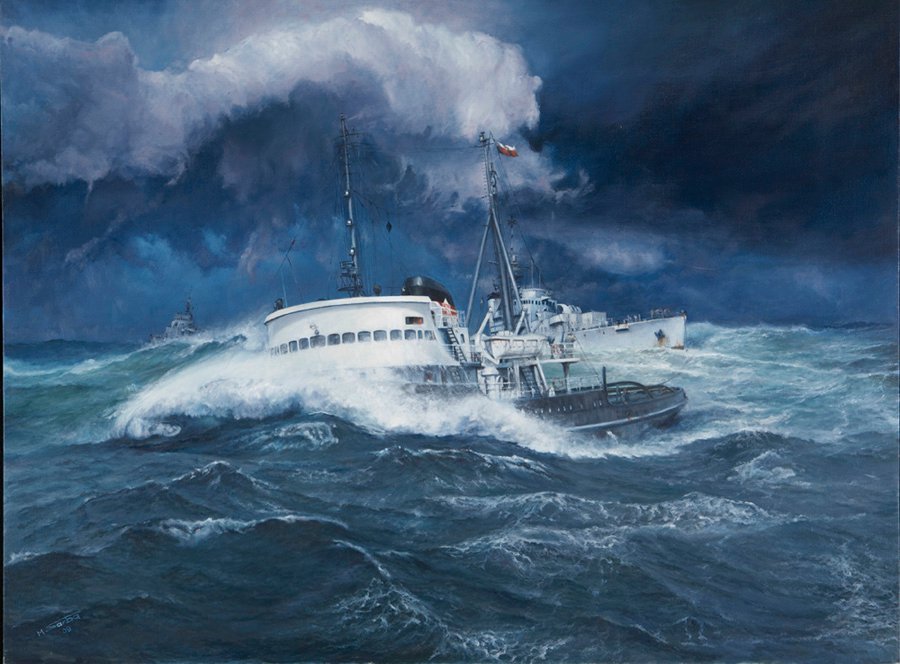Temporary Line
The Rescue of Cap de Madeleine and La Hulloise, Halifax, Nova Scotia, January, 1966
oil on canvas, 30” x 40”
$30,000
The ocean tug "Jantar" was directed to the typical towing work of towing two Prestonian-Class frigates from Halifax (Canada) to La Spezia (Spain) going to a scrap. The North Atlantic crossing was very difficult. The wind was gusting to a strength of 10 in Beaufort scale. Waves, wind and heavy icing agonize the tug all the way across the North Atlantic however, “Jantar “passed the Sambro lighthouse early morning and soon reported at contractual time in Halifax mooring at the waiting frigates "317" ("Cap de Madeleine") and "305" ("La Hulloise”). Very soon Jantar's crew found out about the unpreparedness of the wrecks for towing due to the lack of a towing permit. The situation resulted in securing the wrecks under the surveyor’s supervision, and extended for a few days’ stay in the port. In the meantime, the tug's crew had installed towing equipment and were assigned crew (runners) of three for each wreck. Finally, on January 29th before noon the convoy started to move toward distant Spain. On the main tow hawser was the first frigate “317” and to her stern was attached an intermediate hawser with “305” on the end, one of the typical tandem towing styles.
After two days very bad weather news began to arrive. On the third day of the trip, the weather started to deteriorate, turning into a very severe storm. The wind was gusting to a strength of 11 on the Beaufort scale with a snowstorm. The towed Canadian frigates were invisible. Suddenly, around midnight, an alarm rocket was spotted on the tug bridge behind the stern fired from “317". In a moment the radio news came about the breaking up of the towing line to "305" going as second in tandem. A report from “305” arrived quickly, confirming the situation. Until the very morning "Jantar" stayed near the drifting “305” and finally, with the help of a risky maneuver, it was possible to provide a smaller diameter temporary towing line and attach to the towing hook. This way “305” was first behind the tug stern now before the “317” towed from towing winch. The weather improved slightly, but the advancing squalls hindered progress. After midnight, the alarm rockets again, this time from two wrecks that alerted the crew. A huge wave threw the tug off the course, it crossed the towing lines, breaking line connecting “305” and throwing her on the bow of “317”. A powerful collision in which the “305” suffered a piercing of her hull side above the water line and “317” , her bow was crushed. The hard fight with the closure of watertight compartments on both ships ended with success. The “317” with a crushed bow was holding on on the main hawser and “305” tossed by waves, drifting away from “Jantar”. A new towing line was prepared, but the raging ocean made it impossible to approach again. "Jantar" circled around "305" for five days, until on the fifth day the weather improved and the crew managed to connect the towing line.
The painting shows the moment when the improvement in the weather allowed for the transfer of a new towing line approach, illustrating what happened on “The Fifth Day." In the painting, "Jantar" is approaching the height of the drifting stern "305"("La Hulloise”) and pulling "317"("Cap de Madeleine") with a broken bow at the same time. Low speed causes “317” to set sideways to the waves. The trip lasted 35 days ending on April 3, 1966 in La Spezia, 14 days longer than two more similar journeys as next.
